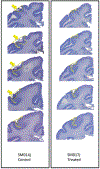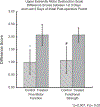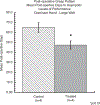Recovery of fine motor performance after ischemic damage to motor cortex is facilitated by cell therapy in the rhesus monkey
- PMID: 23758412
- PMCID: PMC6503838
- DOI: 10.3109/08990220.2013.790806
Recovery of fine motor performance after ischemic damage to motor cortex is facilitated by cell therapy in the rhesus monkey
Abstract
We investigated the efficacy on recovery of function following controlled cortical ischemia in the monkey of the investigational cell drug product, CNTO 0007. This drug contains a cellular component, human umbilical tissue-derived cells, in a proprietary thaw and inject formulation. Results demonstrate significantly better recovery of motor function in the treatment group with no difference between groups in the volume or surface area of ischemic damage, suggesting that the cells stimulated plasticity.
Conflict of interest statement
Declaration of interest
The authors report no conflicts of interest.
Figures







Similar articles
-
Inosine enhances recovery of grasp following cortical injury to the primary motor cortex of the rhesus monkey.Restor Neurol Neurosci. 2016 Sep 21;34(5):827-48. doi: 10.3233/RNN-160661. Restor Neurol Neurosci. 2016. PMID: 27497459 Free PMC article.
-
Cell based therapy enhances activation of ventral premotor cortex to improve recovery following primary motor cortex injury.Exp Neurol. 2018 Jul;305:13-25. doi: 10.1016/j.expneurol.2018.03.010. Epub 2018 Mar 11. Exp Neurol. 2018. PMID: 29540323 Free PMC article.
-
Temporal plasticity involved in recovery from manual dexterity deficit after motor cortex lesion in macaque monkeys.J Neurosci. 2015 Jan 7;35(1):84-95. doi: 10.1523/JNEUROSCI.1737-14.2015. J Neurosci. 2015. PMID: 25568105 Free PMC article.
-
Pathways mediating functional recovery.Prog Brain Res. 2015;218:389-412. doi: 10.1016/bs.pbr.2014.12.010. Epub 2015 Mar 19. Prog Brain Res. 2015. PMID: 25890147 Review.
-
Effects of rehabilitative training on recovery of hand motor function: a review of animal studies.Neurosci Res. 2014 Jan;78:9-15. doi: 10.1016/j.neures.2013.09.008. Epub 2013 Sep 27. Neurosci Res. 2014. PMID: 24080147 Review.
Cited by
-
Assessment of Hand Motor Function in a Non-human Primate Model of Ischemic Stroke.Exp Neurobiol. 2020 Aug 31;29(4):300-313. doi: 10.5607/en20023. Exp Neurobiol. 2020. PMID: 32921642 Free PMC article.
-
Subretinal Human Umbilical Tissue-Derived Cell Transplantation Preserves Retinal Synaptic Connectivity and Attenuates Müller Glial Reactivity.J Neurosci. 2018 Mar 21;38(12):2923-2943. doi: 10.1523/JNEUROSCI.1532-17.2018. Epub 2018 Feb 5. J Neurosci. 2018. PMID: 29431645 Free PMC article.
-
Sex differences in recovery of motor function in a rhesus monkey model of cortical injury.Biol Sex Differ. 2021 Oct 9;12(1):54. doi: 10.1186/s13293-021-00398-9. Biol Sex Differ. 2021. PMID: 34627376 Free PMC article.
-
Inosine enhances recovery of grasp following cortical injury to the primary motor cortex of the rhesus monkey.Restor Neurol Neurosci. 2016 Sep 21;34(5):827-48. doi: 10.3233/RNN-160661. Restor Neurol Neurosci. 2016. PMID: 27497459 Free PMC article.
-
Human Umbilical Tissue-Derived Cells Promote Synapse Formation and Neurite Outgrowth via Thrombospondin Family Proteins.J Neurosci. 2015 Nov 25;35(47):15649-65. doi: 10.1523/JNEUROSCI.1364-15.2015. J Neurosci. 2015. PMID: 26609158 Free PMC article.
References
Publication types
MeSH terms
Grants and funding
LinkOut - more resources
Full Text Sources
Other Literature Sources
